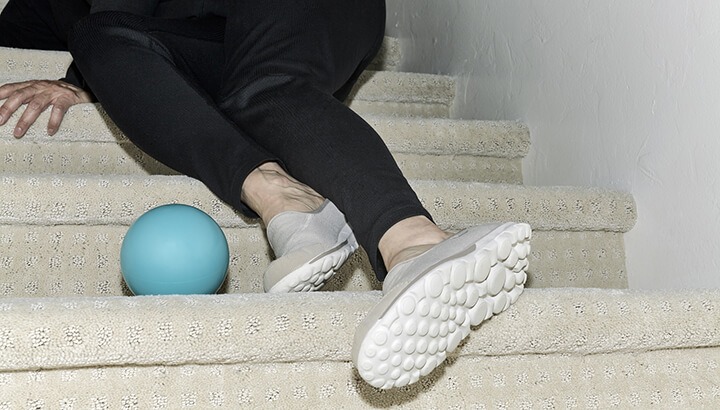There’s a deadly killer lurking in your house, one that could snuff out your life at any moment. I’m not talking about the usual suspects like a gas leak, a poorly installed furnace, or a faulty wiring job. And I’m not talking about some dangerous criminal lurking under the stairs.
I’m talking about the stairs themselves. Yes, you walk on them every day without a second thought but, according to the National Safety Council, almost 12,000 people die from falls on stairs every year in the United States alone.
Risks That Can Trip You Up
I remember getting a family history from a patient early in my career and learning that her father had died in an accident. When I asked what happened…she said that he fell down the stairs. I remember thinking how rare this was. Boy was I wrong! Within a few weeks, I heard another story from a patient about a tragic fall on the stairs. And since then, I’ve seen countless patients who have had their lives changed by falls on stairs.
But when it comes to falls, stairs are hardly the only risks factors out there. Rugs, uneven surfaces, ill-fitting footwear, clutter, poor lighting, and alcohol can all cause a person to lose their balance. An unexpected fall from standing height often results in fractures, lacerations, and severe head injuries. Falls are the leading cause of injury-related deaths in seniors. Indeed, almost all of us know one person who has suffered a severe (even life-altering) injury in a fall.
Preventing Falls
Thankfully, there are some preventive measures you can take to make sure you and your loved ones stay safely on your feet. These include precautions for the home, but also proactive steps you can take to improve your physical coordination, which will help you adjust quickly if you do lose your balance. To begin with, here are some quick tips to make sure your home is a trip-free zone:
- Make sure your staircases are free from clutter and loose carpeting. Also, have safety railings in place and ensure that light switches are located at the top and bottom.
- Ensure all rooms (especially the bathroom) and hallways have good lighting.
- Minimize clutter throughout the house — this helps with sanity too :-)
- Mitigate the dangers of wet floors by installing bath mats and hand railings in bathroom.
- Avoid multitasking while you are walking.
- Wear the right footwear. Socks on hardwood floors can be especially dangerous.
Bettering Your Balance
Improving your fitness and physical coordination can help you stay on your feet. As a surfer and an enthusiast of “board sports” of all kinds…I know the importance of managing imbalance very well. When you are riding board on waves, snow, or asphalt, there are a lot of competing forces trying to tip you in one direction or the other.
As you might expect, it can be quite a challenge to navigate the moment-to-moment changes taking places in such a dynamic situation. But walking is really not all that different– specialists in biomechanics often describe walking as “controlled falling.”
Therefore, the idea of balance as some sort of static quality is somewhat misguided. Indeed, you could even say that balance is something of an idealized fallacy. That is, it’s a useful concept, but what people are really doing is adjusting to competing forces on the fly.
To do this, you have to learn how to challenge your balance. This means engaging in repetitive exercises to sharpen your reflexes, increase muscle strength, and boost your overall physical coordination. To that end, I highly recommend the following activities:
- Heel-to-toe walking. This exercise will help strengthen your calf muscles, which will reduce your risk of getting stress fractures and shin splints. Done regularly, you will improve your sense of position too. Place the heel of one foot just in front of the toes of the other foot. Your heel and toes should touch or nearly touch. Next, pick a spot in front of you and begin to head steadily towards it step by step. Remember, always place your heel just in front of the toe of your other foot. Keep this up for twenty steps. I’d recommend practicing this exercise three times a week.
- Standing on one foot. Doing this simple activity will greatly improve your balance. Just hold on to a sturdy chair, then lift one leg for 10 to 20 seconds before putting it down. Then, repeat with your other leg. Do this routine 10 or 15 times per setting and you’ll really build strength and stability from the ground up.
- High knee walking. This is an exercise that will strengthen your hip flexors and abdominal muscles…which are critical for balance, strength, and stability. It looks a bit like running in place, but lifting your legs much higher than normal. Runners and other athletes use this technique all the time to improve power and flexibility.
- Back leg raises. Here is an exercise that targets your core leg muscles, but it also improves your hips and midsection. Begin on all fours with your hands under your shoulders and your knees underneath your hips. Then, extend one leg behind you as you slowly lift it up to shoulder level. Next, lower your leg slowly. Repeat with your other leg. It’s simpler than it sounds, but here’s a video to help bring you up to speed.
- Tai-Chi. This ancient movement practice has not only stood the test of time… but modern scientific studies have demonstrated that practicing Tai Chi can help seniors cut the risk of falls by 45%.
- Dancing. Research demonstrates that dancing greatly improves neuromuscular coordination. I love that famous quote, “Dance like nobody’s watching.” Yes.
We live most of our lives on hard, flat ground that does not deliver the same level of challenge to our balance systems that we get in the soft, uneven terrain of nature. This mismatch is one of the primary reasons for the lack of balance that is so common in adults. When that evolutionary mismatch is coupled with the natural decline in reflex time that comes with advancing age, you’ve got a recipe for a fall.
It’s imperative to train your body to be more agile. You need to be able to respond quickly and reflexively to sudden changes in your surroundings. Keeping your balance is a matter of learning to exercise mastery at the margins where control seems hardest to maintain. In other words, repeated exercises that challenge your balance will help you keep it in the unexpected situations where you need it most. No challenge…no change.
Take good care,
Dr. Joshua Levitt









